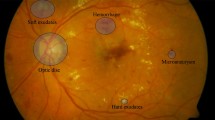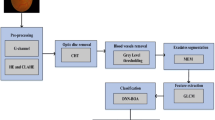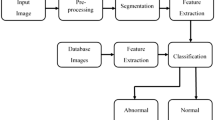Abstract
Due to the ongoing advancement in detection of critical diseases, there is a need in revamping the accurate diagnosis of diabetic retinopathy (DR). In this current study, locust based genetic classifier plays a crucial role in early screening of DR and to determine the exact location of the affected region of retina. Initially, preprocessing is performed to remove the obnoxious information such as noise present in the image and helps to transform the RGB format to gray scale image. It is done by applying wiener filter technique. After removing the obnoxious information, exudate segmentation is performed. After splitting out the image into samples, feature extraction is applied by Gabor based region covariance matrix. It helps to reduce the feature in the DIARETDB1 dataset by obtaining a new feature. After obtaining the feature, whale optimization is performed to pick out the best features such as mean, exudate area, optic distance and standard deviation and finally locust based genetic classifier is used to analogize between trained and test set data and it provides infallible information to the ophthalmologist to provide timely treatments. Comparative analysis is performed. It reveals the significant performance of the current approach over other existing SVM and CNN classifier. The results obtained from the current study shows a promising future and it achieves an accuracy of 98.9%.
























Similar content being viewed by others
References
Adal KM, Van Etten PG, Martinez JP, Rouwen KW, Vermeer KA, van Vliet LJ (2017) An automated system for the detection and classification of retinal changes due to red lesions in longitudinal fundus images. IEEE Trans Biomed Eng 65(6):1382–1390
Aghamohamadian-Sharbaf M, Pourreza HR, Banaee T (2015) A novel curvature-based algorithm for automatic grading of retinal blood vessel tortuosity. IEEE J Biomed Health Inform 20(2):586–595
Bourouis S, Zaguia A, Bouguila N, Alroobaea R (2018) Deriving probabilistic SVM kernels from flexible statistical mixture models and its application to retinal images classification. IEEE Access 7:1107–1117
Cheng J, Li Z, Gu Z, Fu H, Wong DWK, Liu J (2018) Structure-preserving guided retinal image filtering and its application for optic disk analysis. IEEE Trans Med Imaging 37(11):2536–2546
Dai L, Fang R, Li H, Hou X, Sheng B, Wu Q, Jia W (2018) Clinical report guided retinal microaneurysm detection with multi-sieving deep learning. IEEE Trans Med Imaging 37(5):1149–1161
De J, Cheng L, Zhang X, Lin F, Li H, Ong KH et al (2015) A graph-theoretical approach for tracing filamentary structures in neuronal and retinal images. IEEE Trans Med Imaging 35(1):257–272
Deepa V, Kumar CS, Andrews SS (2019) Automated detection of microaneurysms using Stockwell transform and statistical features. IET Image Proc 13(8):1341–1348
Dodo BI, Li Y, Kaba D, Liu X (2019) Retinal layer segmentation in optical coherence tomography images. IEEE Access 7:152388–152398
Dorr M, Elze T, Wang H, Lu ZL, Bex PJ, Lesmes LA (2017) New precision metrics for contrast sensitivity testing. IEEE J Biomed Health Inform 22(3):919–925
Gayathri S, Krishna AK, Gopi VP, Palanisamy P (2020) Automated binary and multiclass classification of diabetic retinopathy using haralick and multiresolution features. IEEE Access 8:57497–57504
Ghazal M, Ali SS, Mahmoud AH, Shalaby AM, El-Baz A (2020) Accurate detection of non-proliferative diabetic retinopathy in optical coherence tomography images using convolutional neural networks. IEEE Access 8:34387–34397
Guo X, Lu X, Liu Q, Che X (2019) EMFN: Enhanced Multi-Feature Fusion Network for hard exudate detection in fundus images. iEEE Access 7:176912–176920
He Y, Jiao W, Shi Y, Lian J, Zhao B, Zou W et al (2019) Segmenting diabetic retinopathy lesions in multispectral images using low-dimensional spatial-spectral matrix representation. IEEE J Biomed Health Inform 24(2):493–502
Jiang Y, Tan N, Peng T, Zhang H (2019) Retinal vessels segmentation based on dilated multi-scale convolutional neural network. IEEE Access 7:76342–76352
Kanimozhi J, Vasuki P, Roomi SMM (2020) Fundus image lesion detection algorithm for diabetic retinopathy screening. J Ambient Intell Humaniz Comput. https://doi.org/10.1007/s12652-020-02417-w
Kumar D, Taylor GW, Wong A (2019) Discovery radiomics with CLEAR-DR: interpretable computer aided diagnosis of diabetic retinopathy. IEEE Access 7:25891–25896
Manivannan S, Cobb C, Burgess S, Trucco E (2017) Subcategory classifiers for multiple-instance learning and its application to retinal nerve fiber layer visibility classification. IEEE Trans Med Imaging 36(5):1140–1150
Mansour RF (2017) Evolutionary computing enriched computer-aided diagnosis system for diabetic retinopathy: a survey. IEEE Rev Biomed Eng 10:334–349
Mary VS, Rajsingh EB, Naik GR (2016) Retinal fundus image analysis for diagnosis of glaucoma: a comprehensive survey. IEEE Access 4:4327–4354
Mateen M, Wen J, Hassan M, Nasrullah N, Sun S, Hayat S (2020) Automatic detection of diabetic retinopathy: a review on datasets, methods and evaluation metrics. IEEE Access 8:48784–48811
Pires R, Avila S, Jelinek HF, Wainer J, Valle E, Rocha A (2015) Beyond lesion-based diabetic retinopathy: a direct approach for referral. IEEE J Biomed Health Inform 21(1):193–200
Saranya P, Prabakaran S (2020) Automatic detection of non-proliferative diabetic retinopathy in retinal fundus images using convolution neural network. J Ambient Intell Humaniz Comput. https://doi.org/10.1007/s12652-020-02518-6
Sarki R, Ahmed K, Wang H, Zhang Y (2020) Automatic detection of diabetic eye disease through deep learning using fundus images: a survey. IEEE Access 8:151133–151149
Seoud L, Hurtut T, Chelbi J, Cheriet F, Langlois JP (2015) Red lesion detection using dynamic shape features for diabetic retinopathy screening. IEEE Trans Med Imaging 35(4):1116–1126
Shahid M, Taj IA (2018) Robust retinal vessel segmentation using vessel’s location map and Frangi enhancement filter. IET Image Proc 12(4):494–501
Sun Y, Zhang D (2019) Diagnosis and analysis of diabetic retinopathy based on electronic health records. IEEE Access 7:86115–86120
Usman I, Almejalli KA (2020) Intelligent automated detection of microaneurysms in fundus images using feature-set tuning. IEEE Access 8:65187–65196
Valarmathi R, Saravanan S (2019) Exudate characterization to diagnose diabetic retinopathy using generalized method. J Ambient Intell Humaniz Comput. https://doi.org/10.1007/s12652-019-01617-3
Wang J, Bai Y, Xia B (2019) Feasibility of diagnosing both severity and features of diabetic retinopathy in fundus photography. IEEE Access 7:102589–102597
Wei H, Peng P (2020) The segmentation of retinal layer and fluid in SD-OCT images using mutex dice loss based fully convolutional networks. IEEE Access 8:60929–60939
Xia H, Jiang F, Deng S, Xin J, Doss R (2018) Mapping functions driven robust retinal vessel segmentation via training patches. IEEE Access 6:61973–61982
Zhang B, Kumar BV, Zhang D (2013) Detecting diabetes mellitus and nonproliferative diabetic retinopathy using tongue color, texture, and geometry features. IEEE Trans Biomed Eng 61(2):491–501
Zhou W, Wu C, Chen D, Yi Y, Du W (2017a) Automatic microaneurysm detection using the sparse principal component analysis-based unsupervised classification method. IEEE Access 5:2563–2572
Zhou L, Zhao Y, Yang J, Yu Q, Xu X (2017b) Deep multiple instance learning for automatic detection of diabetic retinopathy in retinal images. IET Image Proc 12(4):563–571
Author information
Authors and Affiliations
Corresponding author
Additional information
Publisher's Note
Springer Nature remains neutral with regard to jurisdictional claims in published maps and institutional affiliations.
Rights and permissions
About this article
Cite this article
Mohanalakshmi, S., Morarji, C.K. & Soban, S. Locust based genetic classifier for the diagnosis of diabetic retinopathy. J Ambient Intell Human Comput 13, 5447–5463 (2022). https://doi.org/10.1007/s12652-021-03178-w
Received:
Accepted:
Published:
Issue Date:
DOI: https://doi.org/10.1007/s12652-021-03178-w




